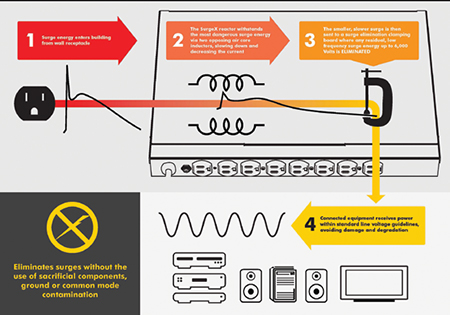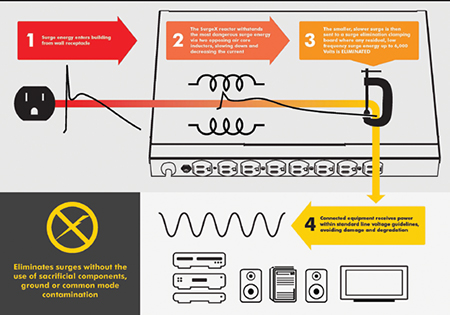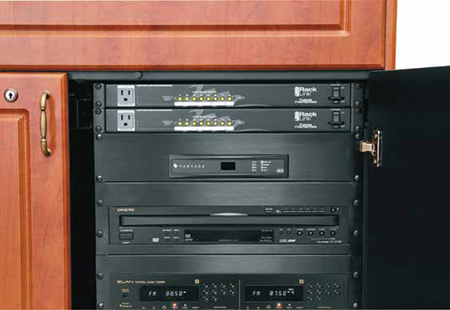Surging Intelligence

SMART POWER MANAGEMENT HELPS IMPROVE PERFORMANCE AND REVENUE STREAMS

SurgeX Advanced Series Models eliminate surge while analyzing breakdown data in case of a problem. As commercial AV systems continue their evolution from analog to digital, this transition presents AV integrators with new challenges. But smart technologies for power management and protection are providing answers to many of these concerns—along with potentially significant performance and revenue advantages.
“Digital equipment, since it’s CPU-based, is just a little more susceptible to conditions that might not trouble an analog piece of gear,” said Mark Tracy, vice president of strategic business and market development for Middle Atlantic Products. “Now that we have so many digital and networked components in our racks, we need to make sure that we’re protecting it right. Surge protection, UPS, cooling, all of those kinds of things really come into play.”
According to Paul Roberts, director of sales for the pro and OEM channels at Core Brands, the increase in products with CPUs and DSP also naturally increases the potential for network freezes and CPU lockups and glitches. As a result, having the ability to remotely perform a hard reboot to return these products to their natural work state is becoming increasingly important, as are technologies that enable integrators to diagnose other potential problems remotely.
Early Adopters Already Remote

Roberts views remote power-management technologies as still being in the early-adopter phase in the AV industry. He has seen them accepted more quickly by home theater integrators than by commercial installers, who favor time-tested technologies to ensure uptime.
“But the people who have had success on the residential side, when they move into the commercial or light commercial arena, they realize that it’s a well-thought-out and a very stable technology and they’re not afraid to use it because they’ve had experience with it,” Roberts said.
A daily selection of the top stories for AV integrators, resellers and consultants. Sign up below.
Technologies to analyze and diagnose power problems remotely are also getting more sophisticated. “Now, we’ve evolved it a step further: at the push of a button, they can analyze the data and they can actually break it down and say, here’s the problem, here’s what you need to do to fix this,” said Dave Perrotta, vice president of operations for ESP/SurgeX.
Some of these systems also incorporate if/then logic that enables the system to address certain problems proactively without any remote action. “Devices like ours can ping an IP address, like a router for instance, and if your router doesn’t respond, it can reboot it,” said Tracy. “The benefit to the integrator when things become networked is that if they put in a little programming time up front, it can save them all kinds of time later on down the road.”
These technologies also give AV integrators the chance to build stronger ongoing partnerships with end users through service contracts. This often can present a promising revenue opportunity without much accompanying effort. “From an integrator standpoint, you don’t even have to roll a truck in a lot of cases to solve some of these problems now,” Perrotta said.
According to Perrotta, the fact that many surge-protection devices also monitor energy usage gives integrators another potential revenue play. “You’re able to provide yet another service to the end user in terms of monitoring energy usage in the environment, and doing audits to help them understand where the majority of that usage is coming from,” said Perrotta. He estimates that 40 to 50 percent of a building’s energy consumption occurs at the plug level.
To provide sound energy management to end users, Tracy additionally recommends that AV integrators follow the best practices and standards outlined in the ANSI/InfoComm AV Systems Energy Management Handbook.
Smart Surge Protection Diversifies

Middle Atlantic’s RackLink Power Management System with Series Protection surge suppression technology, installed in a rack. Beyond remote power management and diagnostic options, leading manufacturers today also offer non-sacrificial surge protection in a growing variety of form factors and devices, including more compact offerings. These allow integrators to properly protect equipment in a growing variety of installation locations beyond the traditional rack, or to provide point-of-use protection suitable for behind increasingly slim displays.
Tracy also recommends that more integrators adopt UPS technology for situations in which quick power outages are common and need to be avoided. But Perrotta cautioned against overestimating the surge-protection capabilities of these products. “A UPS keeps battery power for a short period of time, but that’s basically it,” he said. “They’re not more effective than a cheap surge strip in protecting your devices from electrical noise and surges. Used in combination with the proper surge protection, you’ve got a great solution.”
Better Protection for Better Displays
As more integrators install 4K displays, Roberts sees a greater need both for surge-protection products that protect this greater investment, and for products that filter out EMI and RFI. “As you go up in resolution, the ability for RF to degrade a video resolution is pretty easy to understand,” Roberts said. “You don’t want to pay more money for higher resolution but then not get it because you don’t have clean power. So it’s important to have a professional level of filtering.”
He also noted that while AV integrators will typically include power conditioning on their racks, they sometimes may still have budget-spurred gaps in protection that leave individual plasma displays or mixers vulnerable.
“There’s a relatively small group of power companies that do it right and provide professional-level protection,” Roberts said. “We would all agree that our biggest competition is people plugging things into the wall. If you have professional-level equipment, plug in professional-level power. Then you will get maximum lifespan and maximum performance out of those products.”
Chris Gelbach writes on diverse topics that include careers, marketing, the AV industry, and recreation management.
